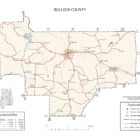Bullock County History by Benjamin Franklin Riley
Bullock County History
by
Benjamin Franklin Riley
Source: Alabama As It Is by Benjamin Franklin Riley, D. D., 1887
Established in 1866, the county took its name from Colonel E. C. Bullock, of Eufaula. It is located in a region which enables it to command all the conditions favorable to prosperity.
Its area comprises 660 square miles.
Population in 1870, 24,474; population in 1880, 29,066. White, 6,944; colored, 22,122.
Tilled Land: 176,860 acres.—Area planted in cotton, 80,470 acres; in com, 47.441 acres; in oats, 6,177 acres; in wheat, 111 acres; in rye, 88 acres ; in sugar-cane, 429 acres ; in rice, 16 acres ; in sweet potatoes, 773 acres. Cotton Production : 22,578 bales.
Directly through the center of Bullock, from east to west, extends a noted range of low hills, which are called Chunnenugga Ridge.
This forms the water-shed for the Tallapoosa river on the north, and the streams that flow into the Gulf on the south. On the north, this low range of hills has an abrupt descent into the prairie lands, which extend to the utmost limit of the county in that direction. On the south, the hills slope gradually away and lose themselves into plains. Bullock has a variety of soils, principal among which are the dark prairie lands, sandy hummocks, gray land, and the white chalky soils. In the northern end of the county are to be seen the black lime lands and the post-oak prairies. Together, they constitute a fertile belt, which stretches across the country, having a width varying from five to ten miles. In the southern portion of the county, or that part which lies south of Chunnenugga Ridge, there is a variety of soils, comprising the loam lands, the growth of which are short-leaf pine, oak, and hickory, then again loam soils, with black-jack, as a prevailing growth, and still again, the thinner or pine lands. The last named soils cover about one-half of the southern territory, the other two the remainder.
The county produces cotton, com, oats, rye, and sweet potatoes, as its staples. The section has long been noted for its capacity to produce cotton especially, and vast quantities of it are raised. But it is as well suited to the production of com. The small grains are receiving more attention of late years. But fully one-half of the tillable soils are devoted to cotton.
The forests support an abundance of such growth as pine, red, post, and white oak, together with elm, poplar, gum, ash. hickory, walnut, chestnut, magnolia, cottonwood, maple, and dogwood.
The county is well watered, throughout, being drained by such streams as Oakfuskee, Capiahatchee, Calibee, Cowikee, Old Town, and Buckhorn creeks. Artesian wells abound. The headwaters of Conecuh river are in this county. These streams generally abound in excellent fish.
Union Springs, the county-seat, and a thriving town of 2,200 inhabitants, Midway, and Enon, are points of importance.
Union Springs is situated on the Georgia Central railroad, just midway between the cities of Montgomery and Eufaula. It is at the intersection of the Georgia Central and the Mobile and Girard railroads. Through these channels of commerce, easy access is had with the cities of Montgomery, Eufaula, Columbus, and Troy. It possesses superior school and church advantages, and has as excellent hotels as any point of the same size in the South. Surrounded by a superior agricultural region, it is a good cotton market. The other points named have also good churches and schools, as has every point in the county which has sufficient population.
The county is highly favored with railway transportation, being penetrated by two railroads, viz : The Montgomery and Eufaula, or the Georgia Central, and the Mobile and Girard railroad. Like most of the other counties in the great agricultural region of the State, no attention has heretofore been called to the capabilities of the soils, the healthfulness, and other numerous advantages which are possessed by Bullock county.
Lands, fertile as they are, and productive of crops in rapid rotation, are purchasable at amazingly low figures in the county. They may be bought for from $2.50 to $10 per acre. The people are highly favorable to such immigrants as would enhance the thrift of the county. There are in Bullock, only 480 acres of government land, which may be settled by those who desire its occupation under the entry act.
For more information on Bullock County, visit the Bullock County Alabama home page.
